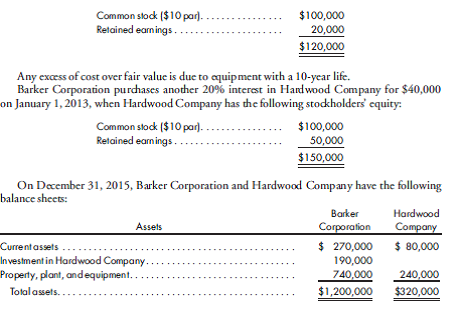
Advanced Accounting 11th Edition by Paul Fischer,William Tayler, Rita Cheng
Edition 11ISBN: 978-0538480284
Advanced Accounting 11th Edition by Paul Fischer,William Tayler, Rita Cheng
Edition 11ISBN: 978-0538480284 Exercise 20
Balance sheet worksheet, mid-year purchase, intercompany bonds and inventory. Book, Inc., acquires all of the outstanding $25 par common stock of Cray, Inc., on June 30, 2014, in exchange for 40,000 shares of its $25 par common stock. On June 30, 2014, Book, Inc., common stock closes at $65 per share on a national stock exchange. Any excess of cost over book value is attributed to goodwill. Both corporations continue to operate as separate businesses, maintaining separate accounting records with years ending December 31.
Additional information is as follows:
a. Book, Inc., uses the simple equity method to account for its investment in Cray.
b. On June 30, 2014, Cray pays cash dividends of $4 per share on its common stock.
c. On December 10, 2014, Book pays a cash dividend totaling $256,000 on its common stock.
d. On June 30, 2014, immediately before the combination, the stockholders' equities are as follows:
e. Cray's long-term debt consists of 10-year, 10% bonds issued at face value on March 31, 2011. Interest is payable semiannually onMarch 31 and September 30. Book purchases Cray's bonds at the face value of $320,000 in 2011, and there is no change in ownership.
f. During October 2014, Book sells merchandise to Cray at a total invoice price of $720,000, which includes a profit of $180,000. At December 31, 2014, one-half of the merchandise remains in Cray's inventory, and Cray has not paid Book for the merchandise purchased.
g. The 2014 net income amounts per the separate books of Book and Cray are $890,000 (exclusive of equity in Cray earnings) and $580,000 ($320,000 in the first six months and $260,000 in the second six months), respectively.
h. The retained earnings balances at December 31, 2013, are $2,506,000 and $820,000 for Book and Cray, respectively.
i. On December 31, 2014, the companies have the following post-closing trial balances:

1. Prepare the worksheet necessary to produce the consolidated balance sheet of Book, Inc., and its subsidiary for the year ended December 31, 2014. Include a determination and distribution of excess schedule.
2. Prepare the formal consolidated statement of retained earnings for December 31, 2014.
Additional information is as follows:
a. Book, Inc., uses the simple equity method to account for its investment in Cray.
b. On June 30, 2014, Cray pays cash dividends of $4 per share on its common stock.
c. On December 10, 2014, Book pays a cash dividend totaling $256,000 on its common stock.
d. On June 30, 2014, immediately before the combination, the stockholders' equities are as follows:

e. Cray's long-term debt consists of 10-year, 10% bonds issued at face value on March 31, 2011. Interest is payable semiannually onMarch 31 and September 30. Book purchases Cray's bonds at the face value of $320,000 in 2011, and there is no change in ownership.
f. During October 2014, Book sells merchandise to Cray at a total invoice price of $720,000, which includes a profit of $180,000. At December 31, 2014, one-half of the merchandise remains in Cray's inventory, and Cray has not paid Book for the merchandise purchased.
g. The 2014 net income amounts per the separate books of Book and Cray are $890,000 (exclusive of equity in Cray earnings) and $580,000 ($320,000 in the first six months and $260,000 in the second six months), respectively.
h. The retained earnings balances at December 31, 2013, are $2,506,000 and $820,000 for Book and Cray, respectively.
i. On December 31, 2014, the companies have the following post-closing trial balances:


1. Prepare the worksheet necessary to produce the consolidated balance sheet of Book, Inc., and its subsidiary for the year ended December 31, 2014. Include a determination and distribution of excess schedule.
2. Prepare the formal consolidated statement of retained earnings for December 31, 2014.
Explanation
1)Determination and Distribution of Exce...
Advanced Accounting 11th Edition by Paul Fischer,William Tayler, Rita Cheng
Why don’t you like this exercise?
Other Minimum 8 character and maximum 255 character
Character 255



